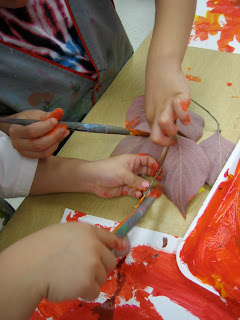

From what I gather, Reggio Emilia style teaching seems to be about children exploring and experimenting with things that interest them. Adults provide materials, media, and general direction as needed, but the children take the ideas where they want.
Since what I know about Reggio Emilia has been through reading on my own, Camp Creek Blog has been a godsend. The blogger, Lori, explains many aspects of Reggio Emilia style of teaching and offers up help. My preschool lesson this week was my interpretation of an idea she presented.
When my preschoolers came in this week, I gave them no specific instruction. There were branches full of brightly colored leaves, paint palettes, brushes and paper on the tables. The children were directed to the tables and told that they could use the supplies as they wanted.
Most children started by experimenting with the brushstrokes they have used before. As soon as they started using their second colors, many expressed excitedly that the colors were changing to new ones.

Some worked on filling up the paper.

This child observed the leaves and was inspired to paint a tree.

This little girl tentatively decided to paint on a leaf.


As other children caught on, they began painting leaves as well. Some began printing them.

This child printed her leaf on the painted tree branches.

Children were excited to discover seeds on the branches.

They were intently focused as they began painting entire branches.

I was fascinated at how cooperatively they worked together. Many of the students in this class speak English minimally, and my guess is that at least 80% of them speak a different language at home.

Since art is a language unto itself, the children could understand what each other was doing without understanding each other's words.

Their classroom teacher was fascinated with how intently the children were working on this lesson. Excitedly, she said that she was going to expand on the exploration with paint and branches in her classroom.
During this lesson, the children experimented with color mixing, printmaking, mark making and working three dimensionally. They explored leaf colors; tree seeds; and how branches, seeds and leaves are connected together. So, through the experience the children integrated art and science.
Debriefing at the end of the lesson is difficult with this group because of time constraints ( it is a 30 minute class) and language barriers. Once clean up begins the focus disapates away from the experience and the moment seems lost. I'm not sure how to tie up the lesson after this. Do I need to tie things up as a group or is talking individually to the children as they are working the same thing?

5 comments:
what a fantastic provocation, bringing in the leaves and whole branches along with the paint colors.
your pictures really tell the story of the children moving from one idea to another (from painting the paper to painting the leaves to printing with the leaves, and so on) and taking ideas from one another and building on them.
it's wonderful that the teacher was excited by the work you were doing with the children and that she might extend it in class. ideally, the two of you could work together to keep this integration of art and science going.
re: tying things up at the end of class .. ideally you would display the children's artwork and talk with them about it, then allow them to keep extending it with their own ideas. i know this is difficult for you because of the way art is done in your school.
with so little time allowed, you can't do as much discussion at the end - and at the beginning - as you would like. it would be great if you could have let the children talk about their work, show it to one another, and discuss it after class. (maybe you could arrange with the teacher to do this in the future? i know that might not be possible.) then they could talk about their plans for next time .. and before the next class, you could remind them of those plans. that would be the *ideal* situation; i realize you are working under serious constraints.
still, what you accomplished here is wonderful, and so full of promise and possibility!
I was the studio teacher at Lori's school- she sent me this link. What a great beginning into reggio! I just wanted to encourage you to keep it up.
Found you via Lori's blog. I loved this post. I don't know much about Reggio myself, only what I have read on Lori's blog, but I find it fascinating.
Very inspiring lesson! I love how the children discovered so much from this simple activity. It makes me realize how much I need to step back and let my kids show me the world through their eyes, rather than imposing my views on them. They teach me a lot by what they notice. I wish there were more Reggio Emilia schools in the U.S.
Thank you for keeping Reggio Emilia alive in your classroom! As a former, soon to return, preschool teacher in the Reggio Emilia philosophy, I would recommend "webbing" with the children the following day/class. Write the central idea in the middle circle on a large poster board. Have each child dicuss what he or she saw, the action he or she took, thoughts/feelings, etc.,each topic branching out for the individual child's response. Display this web with the artwork. You could also record (audio or video)the discussion as a means to return to it later. Good luck!
Post a Comment